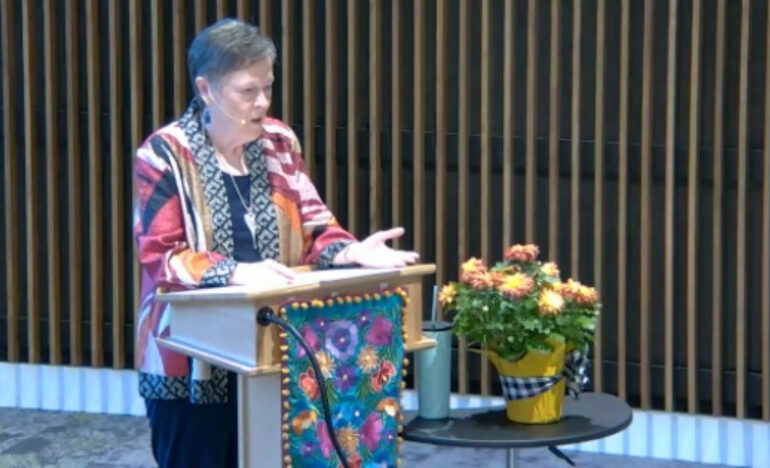Built on Solid Foundations: The Teaching of Jesus and the Buddha

By Kathy Keary
Part 7. Read all the parts of the Jesus and Buddha series here.
Throughout our contemplative life series, we have shed light on ways to cultivate the contemplative life — a life centered in the Sacred that propels an individual into the world to share the love which they have so generously been given. We have emphasized that contemplative prayer goes way beyond navel-gazing. The habitual practice informs who the contemplative is and impacts their way of life. The gifts that are received in contemplative prayer are then shared with others in the form of compassionate presence and loving service.
Jesus and Buddha, both contemplatives, were fully aware that people need a sturdy foundation to help them avoid common pitfalls and ground them in righteousness. They were not ignorant of the many forces that can lead one astray. They knew wholeheartedly of the importance and impact of sound guidance and prayerful practice. Their messages have stood the test of time and continue to inspire followers to walk the narrow path.
In the Gospel of Luke, Jesus instructs:
I will show you what someone is like who comes to me, hears my words, and acts on them. That one is like a man building a house, who dug deeply and laid a foundation on rock; when a flood arose, the river burst against his house but could not shake it, because it had been well built. But the one who hears and does not act is like a man who built a house on the ground without a foundation. When the river burst against it, immediately it fell, and great was the ruin of that house (Luke 6:47-49).
Jesus’ public life stands as a testament to this teaching. The Gospels relay that he nurtured his spiritual life by going off by himself to commune with the Father centering himself in the sacred mystery. Once renewed in spirit, he joined the apostles in acts of mercy, healing, and compassion. Clearly, his actions sprung from his well-fortified relationship with the Father. He epitomized the contemplative life.
New articles in this series are posted to the website every Monday. The full series can be found here: An Invitation to Something New: The Contemplative Life. On Thursday’s we’ll send an email to remind you of the articles
Buddha delivers a similar message: “As rain leaks into a poorly roofed house, so does passion invade an uncultivated mind. As no rain leaks into a well-roofed house, passion does not invade a cultivated mind” (Dhammapada [Scripture] 1:13-14).
The essence of Buddha’s teachings can be found in the Eightfold Path, also known as the Path of Liberation. It is the means by which one can reach enlightenment and is meant to be followed in daily life. The eight parts are grouped into three paths: wisdom, ethical conduct, and mental disciplines.
Barbara O’Brien in her article, “Eightfold Path: The Way of Enlightenment in Buddhism,” describes these eight teachings that are to inform one’s life: Eightfold Path: The Way to Enlightenment in Buddhism (learnreligions.com)
- Right View or Right Understanding: Insight into the true nature of reality
- Right Intention: The unselfish desire to realize enlightenment
- Right Speech: Using speech compassionately
- Right Action: Using ethical conduct to manifest compassion
- Right Livelihood: Making a living through ethical and nonharmful means
- Right Effort: Cultivating wholesome qualities and releasing unwholesome qualities
- Right Mindfulness: Whole body-and-mind awareness
- Right Concentration: Meditation or some other dedicated, concentrated practice
Right View speaks of perceiving the true nature of ourselves and the world around us. Right intention speaks of the commitment and energy required to fully practice the teachings of Buddhism. These fall under the Wisdom Path.
The Ethical Conduct Path includes Right Speech, Right Action, and Right Livelihood. They call us to our better selves practicing loving kindness to others in our daily life.
The Mental Discipline Path includes Right Effort, Right Mindfulness, and Right Concentration. Right Effort is needed to live out the other parts of the path. In his book, No-Nonsense Buddhism for Beginners, Noah Rasheta elaborates: “Right effort is about dedicating the time and work required to become more mindful and aware of the nature of reality. Without that effort, there can be no awakening or enlightenment.”
Right mindfulness deals with being present in the moment whether we are meditating or going about our daily lives. Thich Nhat Hanh asserts: “Mindfulness gives rise to and nourishes happiness.”
Note: Never miss an article published on the Renewal Center website: Sign up to receive our newsletters
In Right Concentration, the practitioner focuses on a mental or physical object. Bhikkhu Bodhi, a Buddhist monk, describes this as “the intensified concentration that results from a deliberate attempt to raise the mind to a higher, more purified level of awareness.”
Both Jesus and Buddha prescribed a way of life that includes both being and doing. Each state strengthens and invites the other. Contemplative prayer fosters this life-giving dynamic.
References
Borg, Marcus. Jesus and Buddha: The Parallel Sayings. Berkley, California: Ulysses Press, 2004.
O’Brien, Barbara. “Right Concentration in Buddhism.” Learn Religions, January 21, 2019. Right Concentration: The Buddhist Eightfold Path (learnreligions.com)
O’Brien, Barbara. “The Eightfold Path: The Way to Enlightenment in Buddhism.” Learn Religions, January 21, 2019. Right Concentration: The Buddhist Eightfold Path (learnreligions.com)
[Kathy Keary, a Precious Blood Companion and spiritual director, holds a master’s degree in theological studies and is a graduate of the Atchison Benedictine’s Sophia Center’s Souljourners Program, an intense study of spirituality and spiritual direction. Kathy believes that the divine is present and active in all of life and encourages others to be awakened to the God in all including the divine within. She enjoys accompanying others on their journey to wholeness discovering the person they were created to be.]
Image © by Susbany from Pixabay
We’d Like to Hear From You!
We’d like to know what you think about this article. Send us a comment using the form below. Do you have a suggestion? Is there something you want to learn more about? Send us a note.
Related

Discover Lectio Divina
Presented by Kathy Keary
This is a recording of “Discover Lectio Divina” presented by Kathy Keary at Precious Blood Renewal Center in Liberty, Missouri, on Oct. 2, 2025.

Do You Hear What I Hear?
By Fr. Garry Richmeier, C.PP.S.
How can we avoid the harmful affects of the polarization that characterizes so much of our lives these days? One step toward this end is to cultivate a greater understanding and appreciation for the idea of relativity in human behavior.
Categories
Assembling God's Puzzle Coffee with Padre Cooking & Spirituality Encounters of the 4th Kind Family Matters Guided Meditations Reflections on the Eucharsitic Prayers Spiritual Resources Taize Prayers Teach Us to Pray The Contemplative Life Traveling with Pilgrims of Hope Uncategorized Videos Week of Prayer for Christian Unity When you need a little help
